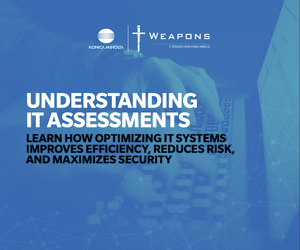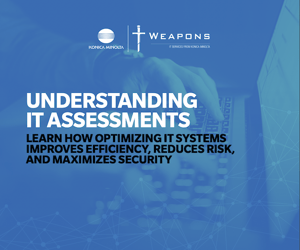Introduction
Today’s IT environments are complex, and it can be difficult to keep all balls in the air at once. Between security, performance, firefighting, compliance, and risk mitigation, 100% efficiency 100% of the time is impossible. Although it is unrealistic to expect every IT system to always run at optimal levels, it is possible to pinpoint actual and potential issues early and address them to minimize disruptions and maximize efficiency.
IT assessments can be a powerful tool in your infrastructure protection and maintenance strategy. They can help identify major security issues or other problems that could be very costly down the road (if those issues aren’t addressed and repaired quickly). First, however, you need to understand the different types of assessments and how to use the results to improve your IT processes, policies, and practices in order to take an educated step toward the right assessment.
Do I need an IT assessment?
Let’s start by admitting that no one likes to be judged, and placing your organization’s IT environment under the microscope sounds like a fast track to Judgmentville. But just like your own annual checkup, conducting regular IT assessments ensures all systems are working properly and identifies areas that need improvement. Yes, it can be a bit uncomfortable, but the alternative is way worse.
So let’s rip off the proverbial Band-Aid and take a closer look at IT assessments — and while we’re at it, IT health checks and IT audits — and how, together, they can improve almost every aspect of your organization’s IT ecosystem.
Why IT Assessments, IT Health Checks, and IT Audits Are Important
At first glance, assessment, health check, and audit sound pretty synonymous, but when you dig a little deeper, each process plays a specific role in maintaining IT health and security. A simplified way to look at it is that audits give you the big picture, health checks take care of the day-to-day maintenance, and assessments give you your marching orders.
In broader terms:
- An IT assessment is a comprehensive review of a company’s technology, infrastructure, security, policies, procedures, and IT system health that results in actionable suggestions for improvement.
- A health check monitors systems to make sure they are performing as expected and addresses issues that crop up.
- An audit measures how well your organization is meeting certain standards or conforming to a set of criteria.
How to Pick the Right IT Assessment Partner
The “whys” for scheduling regular IT assessments are fairly straightforward: Assessments help your IT team optimize system performance, increase system/data/network security, and identify issues and vulnerabilities early.
But to achieve these goals, IT assessments need to dig deep, so it is important to select the right service provider. Look for someone who looks beyond the business relationship and takes on the role of a trusted partner.
Be sure your assessment is done by someone who understands your business objectives and challenges so they can hone in on issues that may affect your company’s success. And finally, don’t forget to check credentials and references. Due diligence is key to seeing the maximum benefit from this partnership.
Now that you know the benefits of IT assessments, IT health checks, and IT audits, and you know what to look for in a service provider, let’s dive deeper into the practicalities and pitfalls of IT assessments.









